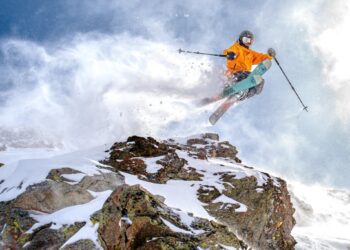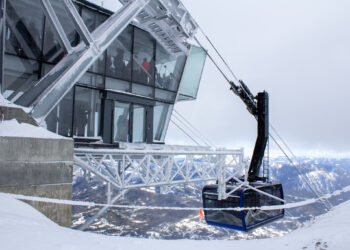Water and Sewer board tables topic for further review, otherwise approves second reading of ordinance
By Jack Reaney STAFF WRITER
Big Sky’s new Water Resource Recovery Facility may come with a ban on salt-based water softeners in an effort to protect the upgraded plant, the Gallatin River and local ecosystem.
More than an hour of the Big Sky County Water and Sewer District board meeting on Tuesday, Feb. 21 was spent discussing the district’s proposed ban on sodium-softened water.
The proposed regulation is part of an ordinance that would also regulate the discharge of fats, oils and grease by local restaurants, and crackdowns on phosphorus discharge, respectively. Significant phosphorus waste can come from larger scale processes including laundry, according to District General Manager Ron Edwards.
“Our engineers have told us our background phosphorus levels—from detergents and things—are higher than what most communities typically see,” Edwards told the board. “So we’re trying to put some language in [the ordinance] to address that.”
The regulation on fats, oils and grease will protect the new plant’s membrane bioreactor, Edwards told EBS.
After long board discussion, the ban on water softeners was eventually removed from the ordinance draft and tabled for further review. The other components of the ordinance were approved on second reading, enabling the board to move forward on fats, oils and grease, and phosphorus.
During the meeting, District Water Superintendent Jim Muscat said that Mountain Village water has a hardness of about 63 milligrams per liter of calcium carbonate, just above the 60 mg/L threshold which defines “medium-hard” water.
“Anything above 180 [mg/L] is considered very hard,” Muscat said. “The meadow is 280. We’ve got really hard water here… It is an issue and that’s why some people want softeners.”
Public pushback
Brian McCollum, owner of Bozeman-based PureWater Technologies, told the board during public comment that he’s worked in many sectors of the water treatment industry for 27 years, and operated in Big Sky for 24 years.
“My clients, some are in this room, and have hundreds of millions of dollars of assets that need protecting… I’m simply here to ask a few questions,” McCollum said. “What is the purpose of this ban? What outcomes do you feel this will achieve? [I ask the board] to define the actual issue at hand, and the science behind it.”
McCollum suggested that the community may deserve further notification “as this affects everyone in this community,” and asked for more time in a future board meeting to discuss water-softening regulations.
Bozeman Health Chief Operations Officer Kallie Kujawa also provided public comment, saying that the ban could prevent Big Sky Medical Center from providing some critical services.
“Without soft water, Big Sky Medical Center could not comply with manufacturers requirements and specifications for essential medical equipment,” Kujawa said.
She requested the hospital be exempt from any ban on water softeners, in order to prevent a significant increase in the quantity of soap and cleaners required. Edwards told EBS that the hospital has a unique situation and is likely to get the requested exemption.
Bill Vetter, a water consultant and chemist with PureWater, asked whether testing had been done on the amount of sodium coming from area wells. Vetter said he pulled samples from Big Sky’s various district areas, and his results varied from 30 to 378 mg/L.
“My concern there is that if sodium is the issue, we need to look at where it’s coming from,” Vetter said.
He added that human waste includes roughly 2,500 milligrams of sodium per day per person, and 90% of that would reach the water treatment plant.
“Have you identified where the sodium is coming from? Is it coming from the water? Is it coming from the softeners? Is it coming from the human waste coming into the plant?” Vetter asked. “When we can determine what that [source] is, then we can have a better idea of what the impact of water softening might be.”
A sudden rise in wastewater sodium levels
After hearing public comment, the board opened their official second reading of the ordinance.
Board member Mike DuCuennois suggested that the board seems short on background information on water softeners and the impact of sodium, though he noted that he wasn’t part of the subcommittee that drafted the ordinance. He pointed out the costs a ban could incur on district-area businesses required to replace water softening technology.
“We started this program to curb any detriments to our wastewater treatment plant,” DuCuennois said. “Sodium levels that we’re talking about here are not detrimental to our new plant, according to [WRRF engineer Scott Buecker]. I talked to Scott at length yesterday, and he said the plant can deal with [sodium] fine. I think we run into a little bit more of an issue with the reclaim [water], and how we deal with the reclaim.”
In a statement to EBS, board member Peter Manka wrote that “High levels of salt and chlorides in our reuse water” could hurt that water’s value and negatively affect district ratepayers. He added that “[It also exposes] us to potential litigation and limits on reuse of our wastewater. This could have the effect of limiting the issuance of new water and sewer permits thereby constraining future development.”
He told the board that the district’s wells average 12-15 mg/L of sodium, not significant compared to magnesium and calcium content.
The sodium level of wastewater coming into the plant was historically between 20-25 mg/L, Manka said, likely due to human waste and saltwater treatment systems—mostly residential.
“We watched that level basically climb from 20 to 150 [mg/L] last summer,” Manka said. “That level has stabilized somewhere in the 100 [mg/L] area, which we continue to monitor weekly. Those numbers don’t waver, we don’t have any drops [below 80].”
Manka told the board that sodium concentration has increased five- to seven-fold in the past 12 to 18 months. He told EBS a study by BSCWSD and consulting engineers attributed “several large commercial projects that have been recently implemented” as the primary source of sodium increase.
Edwards told EBS the Wilson Hotel, Montage and Powder Light are “the obvious ones.”
Over the past 15 to 20 years, Manka added, salt-softeners have been regulated or banned in 15 states and hundreds of communities for the same phenomenon. Many of those communities, like Big Sky, reuse their wastewater or have sensitive discharge areas.
Manka wrote, “The important consideration here is that Big Sky reuses all of its treated wastewater, so every pound of salt that is used in a saltwater softener in the district ends up as a pound of salt input into the Big Sky ecosystem either by being irrigated onto the golf course or potentially used for snowmaking on the mountain, deep well injection, etc.
“This means that the hundreds of thousands of pounds of salt imported into Big Sky every year as a result of large commercial salt softening systems end up in our environment,” Manka wrote.
When board discussion turned to alternatives, McCollum pointed to “issues that have happened around town—I won’t talk about it.”
Potential water-softening alternatives
PureWater’s Vetter said that he’s working on a residential project in a location where sodium levels are higher than 700 mg/L, and a process called “weak-acid injection”—without salt softening—has reduced the levels to 200 mg/L.
“[That process] does not remove the sodium or chloride from the water, so we have not considered this,” Manka wrote to EBS. “But most communities across the country that face the same issues that we are facing have elected to lower sodium and chloride concentrations by limiting inputs from saltwater softener use.”
Manka added that Lochinvar, one of the largest boiler manufacturers in the world—and most popular in Big Sky—conducted extensive testing and claims that “template assisted crystallization” is a more effective alternative.
McCollum, owner of PureWater, told the board, “there’s many technologies that are out there, we’ve tried them as a company, we’ve had [terrible results]. Again I represent my clients and solutions. So if it doesn’t work, it doesn’t work.”
At the end of the discussion, Vetter volunteered his time as a consultant to the board “to figure out a middle ground” and ensure the ordinance keeps moving forward.















